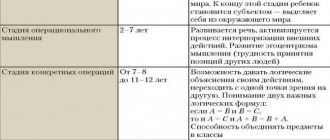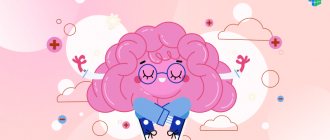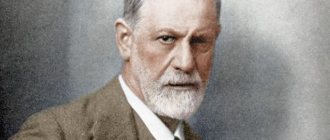Attention span
When studying attention experimentally, its volume . This is the number of unrelated objects that can be perceived simultaneously, clearly and distinctly. In an adult, the volume of visual attention is 3-5 (rarely 6) objects. Junior schoolchildren have 2-4 objects. The volume of auditory attention is usually one less. Training only stabilizes the results at the upper limit. However, the amount of attention also depends on familiarity with the material and interest.
6.2. Neurophysiological mechanisms of attention
One of the most outstanding achievements of neurophysiology in the twentieth century. was the discovery and systematic study of the functions of a nonspecific brain system, which began with the appearance in 1949 of the book by G. Moruzzi and G. Magun “Reticular formation of the brain stem and activation reaction in the EEG.” The reticular formation, along with the limbic system, form a block of modulating brain systems, the main function of which is the regulation of the functional states of the body (see topic 3, paragraph 3.1.3). Initially, only network-like formations of the brain stem were classified as a nonspecific brain system, and their main task was considered to be diffuse generalized activation of the cerebral cortex. According to modern concepts, the ascending nonspecific activating system extends from the medulla oblongata to the thalamus.
Functions of the thalamus.
The thalamus, which is part of the diencephalon, has a nuclear structure. It consists of specific and nonspecific nuclei. Specific nuclei process all sensory information entering the body, which is why the thalamus is figuratively called the collector of sensory information. Specific nuclei of the thalamus are associated mainly with the primary projection zones of the analyzers. Nonspecific nuclei direct their ascending pathways to the associative zones of the cerebral cortex. In 1955, G. Jasper formulated the idea of a diffuse-projection thalamic system. Based on a number of facts, he argued that the diffuse projection thalamic system (nonspecific thalamus), within certain limits, can control the state of the cortex, exerting both an excitatory and an inhibitory influence on it. Experiments on animals have shown that when the nonspecific thalamus is irritated, an activation reaction occurs in the cerebral cortex. This reaction is easy to observe when recording an encephalogram, however, the activation of the cortex during irritation of the nonspecific thalamus is quite different from the activation that occurs during irritation of the reticular formation of the brain stem.
Table 6.1.
Activation reactions of brain structures
| Reaction characteristics | EEG brainstem activation | EEG activation of the thalamus |
| Distribution area | Generalized | Local |
| Reaction type | Tonic | Phasic |
| Temporal dynamics | Slowly fading | Fast fading |
- According to modern concepts, switching activating influences from the level of the reticular formation of the brain stem to the level of the thalamic system means a transition from generalized activation of the cortex to local:
- The first is responsible for global shifts in the general level of wakefulness;
- The second is responsible for selective focus of attention.
Functions of the frontal zones.
The reticular formation of the brainstem and the nonspecific thalamus are closely connected with the cerebral cortex. A special place in the system of these connections is occupied by the frontal zones of the cortex. It is assumed that the excitation of the reticular formation of the brainstem and the nonspecific thalamus along direct ascending pathways extends to the anterior parts of the cortex. When a certain level of excitation of the frontal zones is reached, an inhibitory effect occurs along the descending pathways going to the reticular formation and thalamus. In fact, there is a self-regulation circuit here: the reticular formation initially activates the frontal cortex, which in turn inhibits (reduces) the activity of the reticular formation. Since all these influences are gradual in nature, i.e. change gradually, then with the help of bilateral connections the frontal zones of the cortex can provide exactly the level of excitation that is required in each specific case. Thus, the frontal cortex is the most important regulator of the state of wakefulness in general and attention as a selective process. It modulates the activity of the brainstem and thalamic systems in the desired direction. Thanks to this, we can talk about such a phenomenon as controlled cortical activation.
The attention system in the human brain.
The above diagram does not exhaust all ideas about the brain's support of attention. It characterizes the general principles of the neurophysiological organization of attention and is addressed mainly to the so-called modal-nonspecific attention. A more detailed study allows us to specialize attention, highlighting its modality-specific types. The following types of attention can be described as relatively independent: sensory (visual, auditory, tactile), motor, emotional and intellectual. The clinic of focal lesions shows that these types of attention can suffer independently of each other and different parts of the brain take part in their provision. In maintaining modality-specific types of attention, cortical areas directly related to the provision of corresponding mental functions take an active part (E.D. Khomskaya, 1987). The well-known attention researcher M. Posner argues that in the human brain there is an independent attention system, which is anatomically isolated from the systems for processing incoming information. Attention is maintained through the work of different anatomical areas that form a network structure, and these areas perform different functions that can be described in cognitive terms. Moreover, a number of functional subsystems of attention are distinguished. They provide three main functions: targeting sensory events, detecting a signal for focal (conscious processing), and maintaining vigilance, or the wakeful state. In providing the first function, the posterior parietal region and some nuclei of the thalamus play a significant role, the second - the lateral and medial sections of the frontal cortex. Maintaining vigilance is ensured by the activity of the right hemisphere. Indeed, a lot of experimental data indicates the different contributions of the hemispheres to ensuring not only perception, but also selective attention. According to these data, the right hemisphere mainly ensures a person’s general mobilization readiness, maintains the required level of wakefulness and has relatively little to do with the characteristics of specific activities. The left is more responsible for the specialized organization of attention in accordance with the characteristics of the task.
Switching attention
It differs from distraction in that it is performed by a person consciously. Therefore, a simple transfer of attention to another object cannot be considered a switch: it must be associated with setting a new goal. Initially, it was believed that the ability to shift attention was innate and available to few people. Later it was shown that special training can improve attention switching.
With a high concentration of attention, switching it is difficult. This leads to absent-mindedness, which comes in two forms.
Firstly, there is an inability to concentrate attention for any length of time - it constantly “slides”, a person is constantly distracted. One of the reasons for such absent-mindedness may be an excess of all kinds of shallow interests.
Secondly, there is absent-mindedness as a one-sided concentration of consciousness, when a person does not notice what, from his point of view, seems insignificant. A classic example is the absent-mindedness of a scientist who is absorbed in his work and does not ignore the various “little things in life.”
6.1. Approximate reaction
It is generally accepted that the physiological basis on which involuntary attention develops and functions is an orienting reaction.
Estimated reaction (OR)
was first described by I.P. Pavlov as the motor reaction of an animal to a new, suddenly appearing stimulus. It included turning the head and eyes towards the stimulus and was necessarily accompanied by inhibition of the current conditioned reflex activity. Another feature of OR was the extinction of all its behavioral manifestations upon repetition of the stimulus. The extinct OR was easily restored at the slightest change in the situation (see Reader 6.2).
Physiological indicators of RR.
The use of polygraphic registration showed that OR causes not only behavioral manifestations, but also a whole range of vegetative changes. These generalized changes are reflected in various components of the OR: motor (muscular), cardiac, respiratory, galvanic skin, vascular, pupillary, sensory and electroencephalographic (see topic 2). As a rule, when a new stimulus is presented, muscle tone increases, breathing and pulse rates change, the electrical activity of the skin increases, pupils dilate, and sensory thresholds decrease. In the electroencephalogram, at the beginning of the indicative reaction, generalized activation occurs, which manifests itself in the blockade (suppression) of the alpha rhythm and its replacement by high-frequency activity. At the same time, the possibility arises of unification and synchronous operation of nerve cells not according to the principle of their spatial proximity, but according to the functional principle. Thanks to all these changes, a special state of mobilization readiness of the body arises. More often than others, in experiments aimed at studying OR, indicators of galvanic skin response (GSR) are used. It is particularly sensitive to the novelty of the stimulus and is modally nonspecific, i.e. does not depend on what particular stimulus causes the OR. In addition, GSR decays quickly, even if OR is caused by a painful stimulus. However, GSR is closely related to the emotional sphere, therefore, the use of GSR in the study of OR requires a clear separation of the actual indicative and emotional components of the response to a new stimulus.
Neural model of the stimulus.
The mechanism of occurrence and extinction of OR was interpreted in the concept of a neural stimulus model proposed by E.N. Sokolov. According to this concept, as a result of repetition of a stimulus, a “model” is formed in the nervous system, a certain trace configuration in which all parameters of the stimulus are recorded. An indicative reaction occurs in cases where a mismatch is detected between the current stimulus and the formed trace, i.e. "nervous model" If the current stimulus and the neural trace left by the previous stimulus are identical, then OR does not occur. If they do not coincide, then an indicative reaction arises and, to a certain extent, is stronger, the more different the previous and new stimuli are. Since the OR arises as a result of a mismatch of afferent stimulation with the “nervous model” of the expected stimulus, it is obvious that the OR will last as long as this difference exists. In accordance with this concept, the OR should be recorded for any noticeable discrepancy between two sequentially presented stimuli. There are, however, numerous facts that indicate that OR does not always necessarily arise when the stimulus parameters change.
Significance of the stimulus.
The orientation reflex is associated with the body’s adaptation to changing environmental conditions, therefore the “law of force” is valid for it. In other words, the more the stimulus changes (for example, its intensity or degree of novelty), the greater the response. However, no less, and often a greater reaction can be caused by insignificant changes in the situation if they are directly addressed to the basic needs of a person. It seems that a more significant and, therefore, somewhat familiar stimulus should, other things being equal, cause a smaller RR than a completely new one. The facts, however, tell a different story. The significance of the stimulus is often decisive for the occurrence of OR. A highly significant stimulus can evoke a powerful orienting response with little physical intensity.
- According to some ideas, the factors that provoke OR can be ordered into 4 levels, or registers: stimulus register;
- novelty register;
- intensity register;
- significance register.
Almost all stimuli pass the first level of assessment; the second and third registers work in parallel. Having passed through any of these two registers, the stimulus enters the last one and its significance is assessed there. Only after this final act of evaluation does the entire complex of the orienting reaction develop. Thus, OR does not arise in response to any new stimulus, but only in response to one that is previously assessed as biologically significant. Otherwise, we would experience OR every second, since new stimuli act on us constantly. When assessing the OR, therefore, it is necessary to take into account not the formal amount of information contained in the stimulus, but the amount of semantic, meaningful information. Another important thing is that the perception of a significant stimulus is often accompanied by the formation of an adequate response. The presence of motor components indicates that the OR represents a unity of perceptive and executive mechanisms. Thus, OR, traditionally considered as a reaction to a new stimulus, represents a special case of orienting activity, which is understood as the organization of new types of activity, the formation of activity in changed environmental conditions (see Reader. 6.1).
Sustainability of attention
This is the duration of concentration of consciousness. What does it depend on? When the object of attention does not provide new impressions, attention is distracted from it. Consequently, attention can be maintained only by constantly revealing new content in the object of attention.
Georges Cuvier claims that genius is first and foremost attention. He writes that an intellect that is poor in knowledge, immobile and unoriginal, is unlikely to be able to focus its attention on one subject for long. Therefore, we can say that it is not attention that creates a genius, but genius allows one to maintain stable attention and find more and more new aspects in familiar things.
Other factors of attention stability are:
- interest in the material
- connection of the material being studied with the needs of the individual
- content and complexity of the work performed
- comfortable or distracting conditions in which work takes place
- personality traits (for example, temperament and volitional qualities).
Attention and its main characteristics, Theories of attention
- home
- State exam in the specialty Psychology of Personality (bachelor's degree)
- General psychology
->
->
Answer plan:
1) Concept of attention
2) Physiological basis of attention
3) Main types of attention
4) Basic properties of attention
5) Theories of attention
1) Attention is a cross-cutting mental process consisting in the selective focus of mental activity on an object. (according to N.F. Dobrynin) This is a cross-cutting process that gives a directed, selective character to the entire mental life. Direction is associated with the transition from one activity to another, and concentration is with depth in the lesson. Direction and concentration are closely related. One cannot exist without the other. When an individual directs his attention to something, he simultaneously focuses on it, and vice versa.
Attention takes part in the organization of all cognitive processes (sensation, perception, thinking), being an end-to-end mental process, and performs the following functions :
1) selection of significant stimuli and ignoring unimportant, side effects;
2) retention, preservation of the required activity (or image) until the goal is achieved;
3) regulation and control of activities.
Thus, attention can be considered:
· as a process (sensory, perceptual);
· as a state (concentration);
· as a personality trait (observation).
2) Physiological basis of attention
The physiological basis of attention is the general activation of the brain associated with the activity of the reticular formation. There are several stages or levels of brain activity that provide attention to varying degrees. The most important basis of attention is the achievement of a certain functional state of the brain.
Attention consists of the reaction of orientation to some stimulus or object. In order for an event to be perceived, it must be able to evoke an indicative reaction that will allow us to “tune” our senses to it. Those. attention is reflexive in nature and arises as a result of a special orienting reflex.
The central mechanisms of attention are associated with the excitation of some nerve centers and inhibition of others. In N.S. Some of the emerging excitations turn out to be so strong that they act as dominant ones, suppressing all others. This main excitation is usually called the dominant; all other foci in the nervous system are subdominants. Thus, the most important mechanism ensuring attention is the dominant mechanism, discovered by A.A. Ukhtomsky.
A dominant is a temporarily dominant focus of excitation in the cortex, which inhibits the work of other nerve centers.
3) Main types of attention
The direction and concentration of mental activity can be involuntary or voluntary. In this regard, three types of attention are distinguished: 1) Involuntary - for novelty, sharpness, contrast, significance. It originates from the orientation reflex and is maintained regardless of human consciousness.
2) Voluntary - direction in accordance with the task, controlled consciously, closely related to the will of a person. The main function is the active regulation of the flow of mental processes.
3) Post-voluntary - similar to voluntary, it is purposeful in nature and initially requires volitional efforts, but then the person enters into work: the content and process of the activity, and not just its result, become interesting and significant. Unlike involuntary attention, postvoluntary attention remains associated with conscious goals and is supported by conscious interests. At the same time, unlike voluntary attention, there is no or almost no volitional effort.
4) Basic properties of attention
Selectivity of attention - the ability to select significant stimuli and ignore unimportant ones.
Concentration is the degree or intensity of focused attention.
The volume of attention is the number of impressions that can be perceived with complete clarity and distinctness in one act of attention.
Distribution of attention is a person’s ability to perform several types of activities simultaneously.
Switchability is a conscious and meaningful movement of attention from one object to another.
Stability of attention - the ability to focus on the same object for a certain time
5) Theories of attention
Motor theory of attention N.N. Lange associated attention with the regulation of ideomotor movements, which are carried out during the perception and representation of objects. Attention is the dominance of a given representation at a given moment in time: it is subjective, i.e. for the conscious subject himself, it means to be attentive, to be focused on this impression.
Theory of attention by T. Ribot Attention is always associated with emotions and is caused by them. close relationship between emotions and voluntary attention. The intensity and duration of attention are directly determined by the intensity and duration of the emotional states associated with the object of attention.
Theoretical concept of attention P.Ya. Galperin 1) Attention is a moment of orientation-research activity and psychological action aimed at the content of an image, a thought currently present in the human psyche;
2) the function of attention is control over this content
3) the activity of control, attention does not have a separate special result
4) all specific acts of attention - both voluntary and involuntary - are the result of the formation of new mental actions.
The theory of installation by D. N. Uznadze
Set theory concerns a special kind of pre-tuning state that, under the influence of experience, arises in the body and determines its reactions to subsequent influences.
ADDITIONAL MATERIAL to QUESTION 10. Placed in accordance with the plan item
2) Dominant – a temporarily dominant focus of excitation in the cortex, which inhibits the work of other nerve centers. The dominant (dominant) focus of excitation at a given moment in time, ensuring the performance of any activity, attracts excitation from other centers and simultaneously suppresses them, which blocks extraneous stimuli not related to the activity being performed, and, at the same time, enhances energy excitation of the main dominant focus. The dominant is a stable source of excitement; thanks to it, conditions are created for high concentration and long-term focus. Thus, a person who is passionate about work does not notice hunger, extraneous noises, or the voices of other people.
3) INVOLUTIONARY ATTENTION is the simplest type of attention. It is often called passive, or forced, since it arises and is maintained independently of a person’s consciousness. An activity captivates a person by itself, due to its fascination, entertainment or surprise. The complex of occurrence of involuntary attention includes various physical, psychophysiological and mental reasons. They are interrelated with each other, but they can be roughly divided into the following four categories.
The first group of reasons is related to the nature of the external stimulus, which includes, first of all, the strength (sharpness) or intensity of the stimulus . The contrast between stimuli is also important . Attention is drawn to impressions that differ from the background surrounding them. This group of reasons should also include such quality of the stimulus as its novelty and unusualness . In other words, the more novelty there is in an object, the more complex and interesting it is, the stronger the stimulus and the more often it is repeated, the easier it can attract attention. Thus, the first group of reasons includes the characteristics of the stimulus affecting a person.
The second group of reasons that cause involuntary attention is associated with the correspondence of external stimuli to the internal state of a person and, above all, to his needs. Attention is attracted to everything that more or less corresponds to the ideas or thoughts present in his mind at the present moment.
The third group of reasons is related to the general orientation of the individual . An important role is played by a person’s spiritual needs, interests and expectations. Attracts attention to everything that interests the most and that constitutes the sphere of stable interests, including professional ones. Consequently, the general orientation of the individual, the nature of interests and the presence of previous experience directly affect the occurrence of involuntary attention.
Fourth group. As the fourth independent group of reasons that cause involuntary attention, we should name those feelings that the influencing stimulus causes in us. What causes an emotional reaction is the most important cause of involuntary attention. For example, when reading an interesting book, a person is completely focused on perceiving its content and does not pay attention to what is happening around him.
Unlike involuntary attention, the main feature of VOLUNTARY ATTENTION is that it is controlled by a conscious goal. This type of attention is closely related to the will of a person and was developed as a result of labor efforts, therefore it is also called volitional, active, intentional. The main function of voluntary attention is the active regulation of mental processes.
Both types of attention are closely related to each other, since voluntary attention arose from involuntary attention.
POST-VOLUNTARY ATTENTION , like voluntary attention, is purposeful in nature and initially requires volitional efforts, but then the person gets into the work: the content and process of the activity, and not just its result, become interesting and significant. Unlike involuntary attention, postvoluntary attention remains associated with conscious goals and is supported by conscious interests. At the same time, unlike voluntary attention, there is no or almost no volitional effort.
4) Selectivity of attention consists in the ability to select significant stimuli and ignore secondary ones. Through headphones, two magnetic recordings were simultaneously fed into both ears of the subject. When the subject was asked to listen carefully to one of them, the subject easily repeated the words he heard. But he caught almost nothing from the other recording. It seems that there is a “filter” in the brain that limits the ability to capture signals coming from different sources. However, it was found that this filter does not always work flawlessly. Thus, in auditory perception, it is enough that a particularly important word for him, for example, his name, is spoken into the subject’s other ear for him to automatically change the channel of perception. This limitation of attentional capabilities also manifests itself when the auditory and visual systems operate simultaneously. For example, during a lecture, a student can read an interesting book. However, even if his attention jumps from one channel to another, it is unlikely that he will be able to well understand at least what is being transmitted through one of them, much less both.
Concentration of attention means that there is a focus in which all mental or conscious activity is concentrated. Concentration refers to the degree or intensity of focused attention. Concentration is a consequence of excitation in the dominant focus with simultaneous inhibition of other areas of the cerebral cortex.
Volume. Attention can be characterized in terms of its volume. In psychology, the volume of attention is understood as the number of impressions that can be perceived with complete clarity and distinctness in one act of attention.
According to V. Wundt’s calculations, human consciousness can simultaneously embrace from 16 to 40 simple impressions, while attention can prepare the body to react simultaneously to a much smaller number of impressions - from 6 to 12 - of the same nature. This makes its selective nature completely clear.
Attention span is a variable that varies individually, but usually its indicator in people is 5+2. The volume of attention is a variable value, depending on how connected the content on which attention is focused, and on the ability to meaningfully connect and structure the material.
Distribution of attention is a person’s ability to perform several types of activities simultaneously. For example, simultaneously remembering a poem out loud and making calculations in writing. A textbook example is the phenomenal abilities of Julius Caesar, who, according to legend, could simultaneously do seven unrelated things. It is also known that Napoleon could simultaneously dictate seven important diplomatic documents to his secretaries. It is likely that in this case several things are not being done entirely simultaneously: most likely, there is a very rapid alternation of attention from one to another. Even W. Wundt proved that a person cannot concentrate on two simultaneously presented stimuli. However, sometimes a person is actually able to perform two types of activities at the same time: in cases where one of the types of activities performed is completely automated and does not require attention (for example, ironing and watching TV, embroidery and conversation). If this condition is not met, combining activities is impossible.
As a rule, there is an inverse relationship between the distribution of attention and its intensity: the greater the number of objects that are given attention at the same time, the less attention there is for each individual object.
It should be noted that greater or lesser ability to distribute attention is essential for success in a particular profession. Some activities require greater distribution of attention, while others, on the contrary, can be successfully performed by persons with a weak ability to distribute.
Many authors believe that the distribution of attention is the reverse side of its other property - switchability.
Switchability is a conscious and meaningful movement of attention from one object to another. The ability to switch means flexibility of attention, the ability to quickly navigate a complex, changing situation. The ease of switching attention varies from person to person and depends on a number of conditions (primarily on the relationship between previous and subsequent activities and the subject’s attitude towards each of them). The more interesting the activity, the easier it is to switch to it. A certain role in the speed of switching is also played by the individual characteristics of the individual, in particular, his temperament. It should be noted that switching attention is one of the well-trained qualities.
Absent-mindedness, in the everyday sense of the word, is essentially poor switchability.
Sustainability of attention is the ability to focus on the same object for a certain time.
Experimental research has shown that attention is primarily subject to periodic involuntary fluctuations. Periods of fluctuations in attention (according to N. Lange) are usually 2–3 seconds, reaching a maximum of 12 seconds. These cases of fluctuations, according to many researchers, are directly related to fatigue and adaptation of the sensory organs. Attention left to itself reveals a natural tendency to move from one new impression to another. As soon as its object loses its interest, without delivering any new impressions, attention, against our will, moves to something else.
In addition, the stability of attention depends on a number of conditions. These include: the characteristics of the material, the degree of its difficulty, understandability, the individual’s attitude towards it - the degree of his interest in this material - and, finally, the individual characteristics of the individual.
Thus, attention is a manifestation of the selective orientation of mental activity, an expression of the selective nature of the processes of consciousness. Attention is inextricably linked with all aspects of the psyche. In particular, the role of emotional factors is clearly reflected in the dependence of attention on interest, the role of the will finds direct expression in the fact of voluntary attention.
5) In psychology, there are six main approaches that explain the phenomenon of attention. Each of them considers one aspect to be the main one in the complex complex of human mental activity, but so far none of these hypotheses has received universal recognition. It is possible that the true mechanisms of attention are either a form of integration of the processes described below, or are due to other reasons. The first, emotional, approach to understanding attention was promoted by T. Ribot, who believed that attention is always associated with emotions and is caused by them. Ribot believed that the intensity and duration of voluntary attention is determined by the characteristics of those emotions that are caused by the object of attention. This view of attention is very legitimate, because emotion is the body’s reaction to the likelihood of satisfying an actual need, and the body’s attention is primarily focused on such objects.
The second approach was put forward by scientists I. Herbert and W. Hamilton, who believed that more intense ideas suppress less intense ones, displacing them into the area of the subconscious, and what remains in consciousness and attracts our attention.
The third approach is that attention is interpreted as the result of apperception, that is, the individual’s life experience. At the same time, incoming information is filtered in the nervous system, based on the needs, knowledge and life experience of a person.
The fourth approach was developed by the Georgian scientist D.N. Uznadze, who argued that the attitude internally expresses the state of attention. Uznadze called the process of isolating a certain image under the influence of an attitude from the entire variety of surrounding objects “objectification.”
The fifth approach emphasizes the motor aspect of the attention process. The fact is that involuntary attention is based on an orienting reflex - turning the body to a new source of irritation and adjusting the analyzers to it. These phenomena occur with the active participation of muscles, so attention can be interpreted as a specially organized motor adaptation to the environment.
The sixth approach comes from the physiological concept of attention as a complexly organized focus of excitation in the cerebral cortex, which suppresses the activity of neighboring areas of the brain. Currently, physiologists believe that such a hypothesis interprets the process of attention too primitively, since when concentrating attention very often not only individual areas of the cortex are involved, but the entire brain as a whole.
Motor theory of attention N.N. Lange
A significant contribution to the development of ideas about attention was made by the Russian psychologist N.N. Lange, who developed the theory of volitional attention. Like the French psychologist T. Ribot, he associated attention with the regulation of ideomotor movements, which are carried out during the perception and representation of objects. According to N. Lange, attention is precisely nothing more than the relative dominance of a given representation at a given moment in time: subjectively, i.e. for the conscious subject himself, it means to be attentive, to be focused on this impression.
N.N. Lange, analyzing the most well-known approaches to understanding the nature of attention, combines existing theories and concepts of attention into several groups:
- Understanding as a result of motor adaptation. Adherents of this approach proceed from the fact that since a person can voluntarily transfer attention from one object to another, attention is impossible without muscle movements. It is muscle movements that ensure the adaptation of the senses to the conditions of best perception.
- Attention as a result of limited volume of consciousness. Without explaining what is meant by the volume of consciousness, I. Gerberg and W. Hamilton believe that more intense ideas are able to displace or suppress less intense ones.
- Attention as a result of emotion. This theory received the greatest recognition in English associative psychology. It is based on the statement that attention depends on the emotional coloring of the representation. For example, the statement of the representative of this point of view, J. Mile, is quite well known: “To have a pleasant or painful feeling or idea and to be attentive to them is one and the same thing.”
- Attention as a result of apperception, i.e. as a result of the individual's life experiences.
- Attention as a special active ability of the spirit. Proponents of this position take into account a primary and active ability, the origin of which is inexplicable.
- Attention as an increase in nervous irritability. According to this hypothesis, attention is caused by an increase in local irritability of the central nervous system.
- The theory of nervous suppression attempts to explain the basic fact of attention - the predominance of one idea over another - by the fact that one physiological nervous process, the result of which is the fact of a special concentration of consciousness.
T. Ribot's theory of attention
One of the most famous psychological theories of attention was proposed by T. Ribot. He believed that attention, regardless of whether it is weakened or enhanced, is always associated with emotions and is caused by them. Ribot assumed a particularly close relationship between emotions and voluntary attention. He believed that the intensity and duration of such attention are directly determined by the intensity and duration of the emotional states associated with the object of attention.
Involuntary attention also depends entirely on affective states. “Cases of deep and persistent involuntary attention show all the signs of an indefatigable passion, constantly renewed and constantly thirsting for gratification.” The state of attention is always accompanied not only by emotional experiences, but also by certain changes in the physical and physiological state of the body. Only on the basis of a detailed and thorough study of such states can one get a clear idea of the mechanisms of attention.
T. Ribot emphasized the importance of physiological connections between mental processes and states, and this circumstance affected his interpretation of attention. Thus, Ribot's theory can be called psychophysiological. Attention, as a purely physiological state, has a complex of vascular, respiratory, motor and other voluntary or involuntary reactions.
Intellectual attention increases blood circulation in the organs of the body engaged in thinking. States of concentrated attention are also accompanied by movements of all parts of the body: face, torso, limbs, which, together with the organic reactions themselves, act as a necessary condition for maintaining attention at the proper level.
Movement, according to T. Ribot, physiologically supports and enhances this state of consciousness. For the senses (vision and hearing), attention means focusing and delaying movements associated with their adjustment and control.
The effort we put into focusing and maintaining attention on something always has a physical basis. It corresponds to a feeling of muscle tension, and subsequent distractions are associated, as a rule, with muscle fatigue in the corresponding motor parts of the receptive systems.
T. Ribot believed that the motor effect of attention is that some sensations, thoughts, and memories receive special intensity and clarity compared to others because all motor activity is focused on them.
The secret of voluntary attention lies in the ability to control movements. By voluntarily restoring movements associated with something, we thereby draw our attention to it. These are the characteristic features of the motor theory of attention proposed by T. Ribot.
Theoretical concept of attention P.Ya. Galperin
Among domestic psychologists P.Ya. Halperin put forward an original interpretation of attention. The main provisions of his concept are as follows:
1) attention is one of the moments of orientation-research activity and is a psychological action aimed at the content of an image, thought, or other phenomenon currently present in the human psyche;
2) in its function, attention represents control over this content. Every human action has an orienting, performing and control part. The latter is represented by attention as such;
3) unlike actions aimed at producing a specific product, control activities, or attention, do not have a separate special result;
4) from the point of view of attention, as an activity of mental control, all specific acts of attention - both voluntary and involuntary - are the result of the formation of new mental actions.
The theory of installation by D. N. Uznadze
It may be worth considering a theory that links attention to the concept of attitude. The theory of installation was proposed by D.N. Uznadze and initially concerned a special kind of state of preliminary adjustment, which, under the influence of experience, arises in the body and determines its reactions to subsequent influences.
For example, if a person is given two objects of equal volume, but different in weight, then he will estimate the weight of other identical objects differently. The one that ends up in the hand that previously held the lighter object will this time seem heavier, and vice versa, although the two new objects will actually be identical in all respects. They say that a person who discovers such an illusion has formed a certain attitude towards the perception of the weight of objects.
The attitude, according to D. N. Uznadze, is directly related to attention. Internally, it expresses the state of a person’s attention. This explains, in particular, why, in conditions of impulsive behavior associated with a lack of attention, a person, nevertheless, can experience very specific mental states, feelings, thoughts, and images.
The concept of objectification is also associated with the concept of attitude in Uznadze’s theory. It is interpreted as the selection, under the influence of an attitude, of a certain image or impression received during the perception of the surrounding reality. This image, or impression, becomes the object of attention (hence the name “objectification”).
Theory of attention L.S. Vygotsky
L.S. tried to trace the history of the development of attention, as well as many other mental functions. Vygotsky. He wrote that the history of a child’s attention is the history of the development of the organization of his behavior, that the key to the genetic understanding of attention should be sought not inside, but outside the child’s personality. Voluntary attention arises from the fact that people around the child “begin, with the help of a number of stimuli and means, to direct the child’s attention, direct his attention, subordinate him to their power, and thereby give into the child’s hands those means with the help of which he subsequently masters his own attention.” " The cultural development of attention lies in the fact that, with the help of an adult, the child learns a number of artificial stimuli-means (signs), through which he further directs his own behavior and attention. With age, the child’s attention improves, but the development of externally mediated attention proceeds much faster than its development as a whole, especially natural attention. At the same time, at school age, a turning point in development occurs, which is characterized by the fact that initially externally mediated attention gradually turns into internally mediated, and over time, this latter form of attention probably takes the main place among all its types.
Differences in the characteristics of voluntary and involuntary attention increase starting from preschool age and reach a maximum at school age, and then again show a tendency to equalize. This tendency is precisely due to the fact that in the process of its development, the system of actions that ensure voluntary attention gradually turns from external to internal.
L.S. Vygotsky writes that from the very first days of a child’s life, the development of his attention occurs in an environment that includes the so-called double series of stimuli that evoke attention. The first row is the surrounding objects themselves, which with their bright, unusual properties attract the child’s attention. On the other hand, this is the speech of an adult, the words he pronounces, which initially act as stimulus-instructions that direct the child’s involuntary attention. Thus, from the first days of a child’s life, a significant part of his attention is directed with the help of stimulus words.
Along with the gradual mastery of active speech, the child begins to control the primary process of his own attention, first in relation to other people, orienting their own attention with the word addressed to them in the right direction, and then in relation to himself.
The general sequence of cultural development of attention according to L.S. Vygotsky is as follows: “First, people act towards the child, then he himself interacts with others, finally, he begins to act on others and only in the end begins to act on himself... First, the adult directs his attention with words to the things around him and thus develops powerful stimulus-instructions from words; then the child begins to actively participate in this direction and begins to use words and sounds as a means of direction, that is, to draw the attention of adults to the object of interest to him.”
The word that an adult uses when addressing a child appears initially as a pointer, highlighting for the child certain signs in an object, drawing his attention to these signs.
During learning, the word is more and more directed towards highlighting abstract relationships and leads to the formation of abstract concepts. L.S. Vygotsky believed that the use of language as a means of directing attention and a pointer to the formation of ideas is of great importance for pedagogy, since with the help of words the child enters the sphere of interpersonal communication, where space opens up for personal development. Initially, the processes of voluntary attention directed by the speech of an adult are, for the child, processes of external discipline rather than self-regulation. Gradually, using the same means of mastering attention in relation to himself, the child moves on to self-control of behavior, i.e. to voluntary attention. Arthur Minimulin
Sources
- Hii J., Hustedt J., Bangs MJ. Residual Malaria Transmission in Select Countries of Asia-Pacific Region: Old Wine in a New Barrel. // J Infect Dis - 2022 - Vol223 - NSupplement_2 - p.S111-S142; PMID:33906222
- No authors found Reproductive Health Care for Incarcerated Pregnant, Postpartum, and Nonpregnant Individuals. // Obstet Gynecol - 2022 - Vol - NNULL - p.; PMID:33906198
- Liu G., Xiao Y., Zhang W., Tang W., Zuo C., Zhang P., Dong S., Luo P. Novel aluminum vanadate as a cathode material for high-performance aqueous zinc-ion batteries. // Nanotechnology - 2021 - Vol - NNULL - p.; PMID:33906187
- Schmitz M., Kesper L., Schulte MGH., Roese P., Berges U., Westphal C. Surface and interface analysis of a low-dimensional Au-Si surface alloy on Au(110) by means of XPS and XPD. // J Phys Condens Matter - 2022 - Vol - NNULL - p.; PMID:33906167
- Cheng Y., Cao J., Tang X., Hao Q. Optical zoom imaging systems using adaptive liquid lenses. // Bioinspir Biomim - 2022 - Vol - NNULL - p.; PMID:33906161
- Li C., Wang R., Yang X., Zhou M., Pan X., Cai G., Zhang Y., Zhu G. Deeper investigation on methane generation from synthetic wastewater containing oxytetracycline in a scale up acidic anaerobic baffled reactor. // Bioresour Technol - 2022 - Vol333 - NNULL - p.125156; PMID:33906019
- Rahmanti AR., Ningrum DNA., Lazuardi L., Yang HC., Li YJ. Social Media Data Analytics for Outbreak Risk Communication: Public Attention on the “New Normal” During the COVID-19 Pandemic in Indonesia. // Comput Methods Programs Biomed - 2022 - Vol205 - NNULL - p.106083; PMID:33906012
- He N., Xiang Y. How child maltreatment impacts internalized/externalized aggression among Chinese adolescents from perspectives of social comparison and the general aggression model. // Child Abuse Negl - 2022 - Vol117 - NNULL - p.105024; PMID:33905994
- Valdez D., Montenegro MS., Crawford BL., Turner RC., Lo WJ., Jozkowski KN. Translation frameworks and questionnaire design approaches as a component of health research and practice: A discussion and taxonomy of popular translation frameworks and questionnaire design approaches. // Soc Sci Med - 2022 - Vol278 - NNULL - p.113931; PMID:33905986
- Florian S., Ichou M., Panico L. Parental migrant status and health inequalities at birth: The role of immigrant educational selectivity. // Soc Sci Med - 2022 - Vol278 - NNULL - p.113915; PMID:33905985
Six Basic Properties of Attention
Definition 1
Attention is a special kind of psychophysiological process that characterizes the dynamic features of cognitive activity, determined by its concentration on a relatively narrow area of internal or external reality, which at a certain point in time becomes conscious and concentrates the physical and mental forces of a person.
Definition 2
Properties of attention are basic tools for understanding mental and behavioral factors that determine the process and ability of a person to receive and perceive various information.
Are you an expert in this subject area? We invite you to become the author of the Directory Working Conditions
In the field of advertising and marketing, experts identify six basic characteristics that determine its properties. In general they are shown in Figure 1.
Figure 1. Basic properties of attention. Author24 - online exchange of student work
The properties of attention and their understanding are important from the point of view of advertising marketing, since attracting the attention of a potential consumer is one of the most important and primary objectives of advertising. Attention, in turn, performs a number of important functions, the main ones of which are:
- selection of incoming information according to the actual needs of the individual;
- ensuring long-term and selective concentration of mental activity on the object of advertising and its content;
- activation of necessary and inhibition of currently unnecessary mental processes.
Finished works on a similar topic
Coursework Basic properties of attention 490 ₽ Abstract Basic properties of attention 250 ₽ Test paper Basic properties of attention 220 ₽
Receive completed work or specialist advice on your educational project Find out the cost
Direct attention accompanies the perception of advertising information by representatives of the target audience and its subsequent processing. At the same time, attention acts as a kind of filter that allows you to filter out unnecessary messages.
Each of the properties of attention presented in Figure 1 has its own specific characteristics and features. Let us consider their essence in more detail.
Conclusions:
- From the obtained data we can conclude that 10 out of 11 (91%) subjects showed good accuracy of attention selectivity (A ≥ 0.70), and only one of the subjects (9%) had this indicator at a rather low level (A = 0 ,56).
A factor in the differences in the data is the condition of each subject and the surrounding environment. - 4 out of 11 subjects showed high work efficiency (90% and above); 5 out of 11 showed normal performance (70-89%); 2 out of 11 showed low performance (below 70%).
The effectiveness of work was mainly influenced (in addition to the above): a) the presence of interest in the object of attention, and also b) volitional effort, compensating for the absence of the first of these factors. Both points characterize this type of attention as voluntary attention. It is formed in childhood under the influence of upbringing, but it can also be developed by performing various exercises on attention (see Appendix 2).
In addition, differences in results can be explained by individual characteristics of attention (see Part II, Chapter 1, § 3).
List of used literature:
- Kozubovsky V. M. // General psychology: cognitive processes. – Mn., 2008.
- Titchener E. // Attention. A textbook on attention. – M., 1976.
- Dmitrieva N.Yu. // General psychology. Cribs. –M.: 2008. - 32 p.
- https://psycabi.net/testy/579-test-myunsterberga-na-vospriyatie-i-vnimanie-diagnostika-izbiratelnosti-vnimaniya
- https://stud-baza.ru/vnimanie-referat-psihologiya-49045
- https://www.kraskizhizni.com/poleznoe/1519-zadania-vnimanie
- https://litlbetr.ru/razvitie-intellekta/razvitie-kontsentratsii-vnimaniya-uprazhneniya-igry.html








